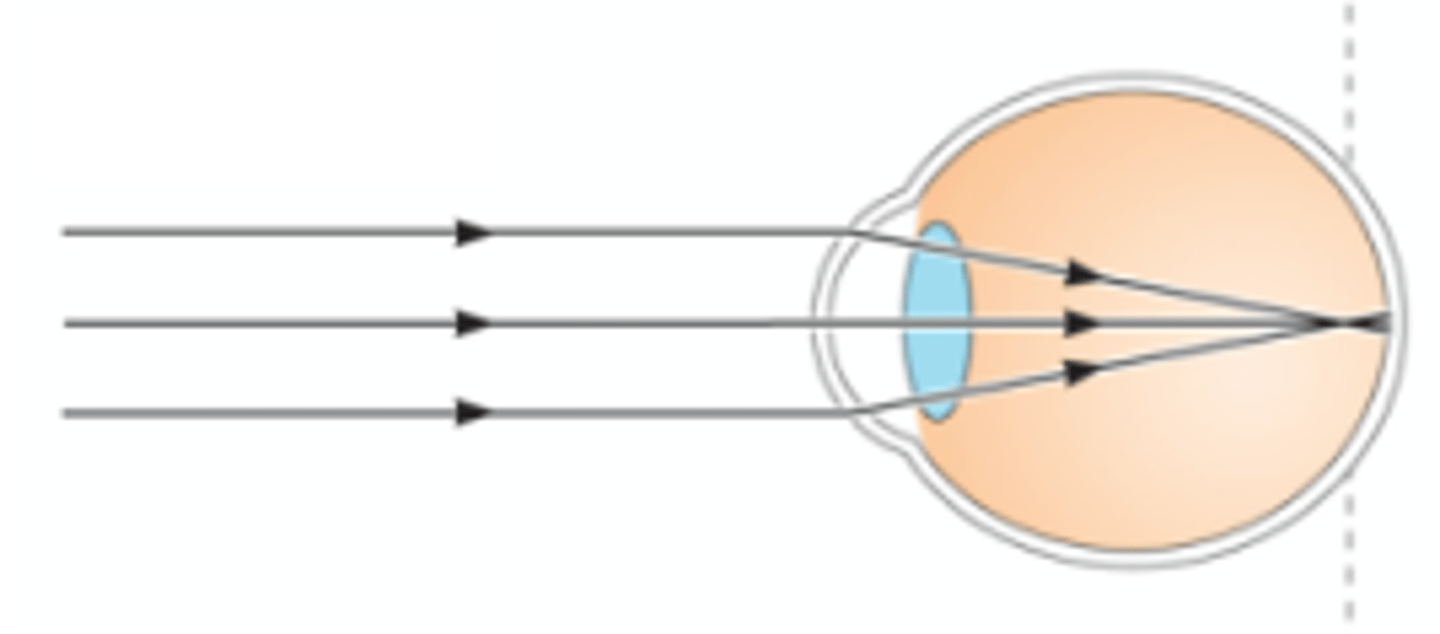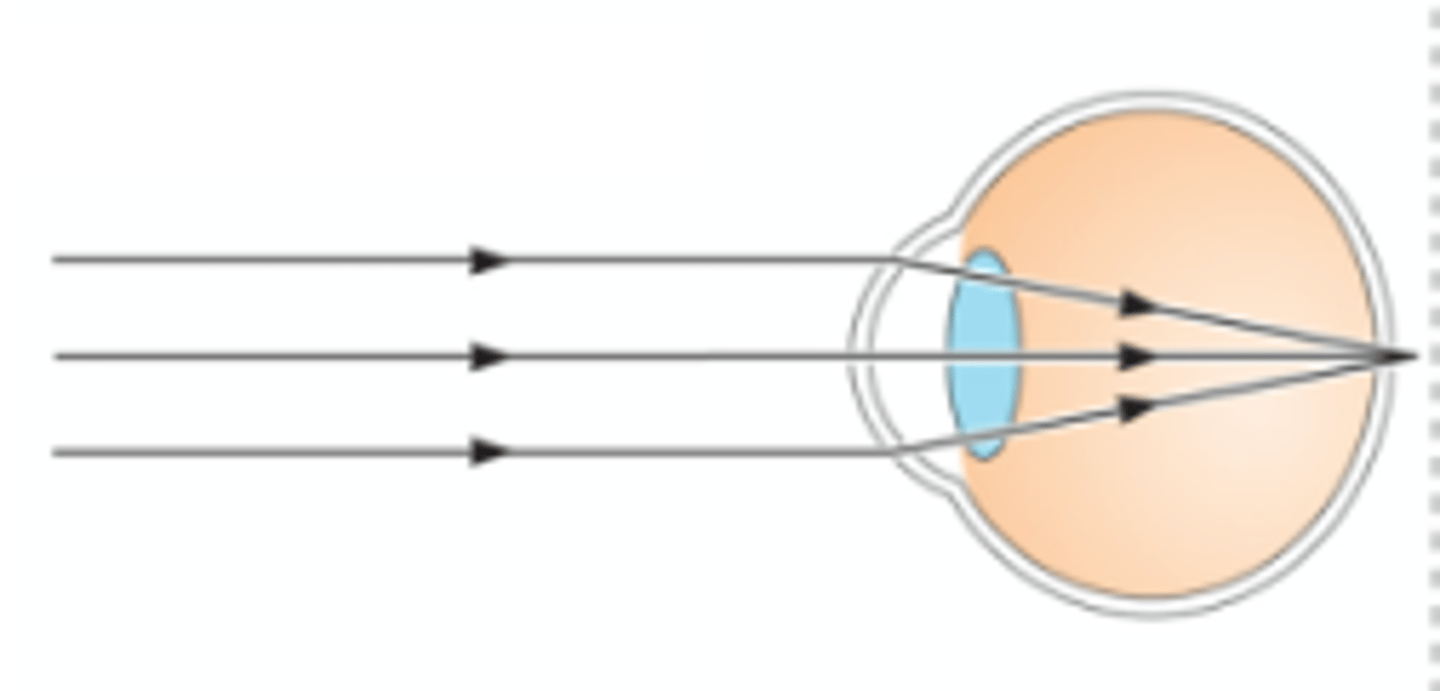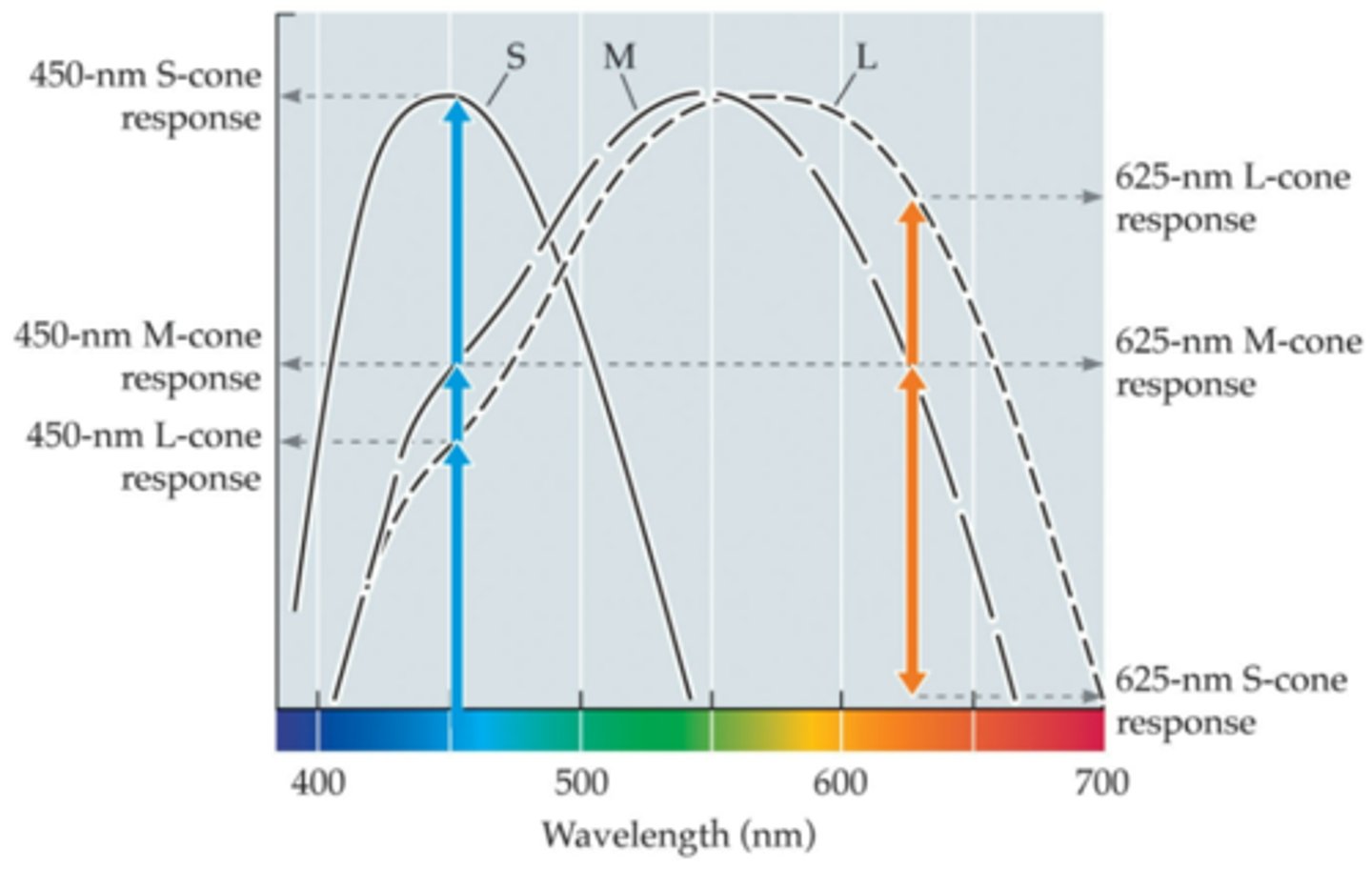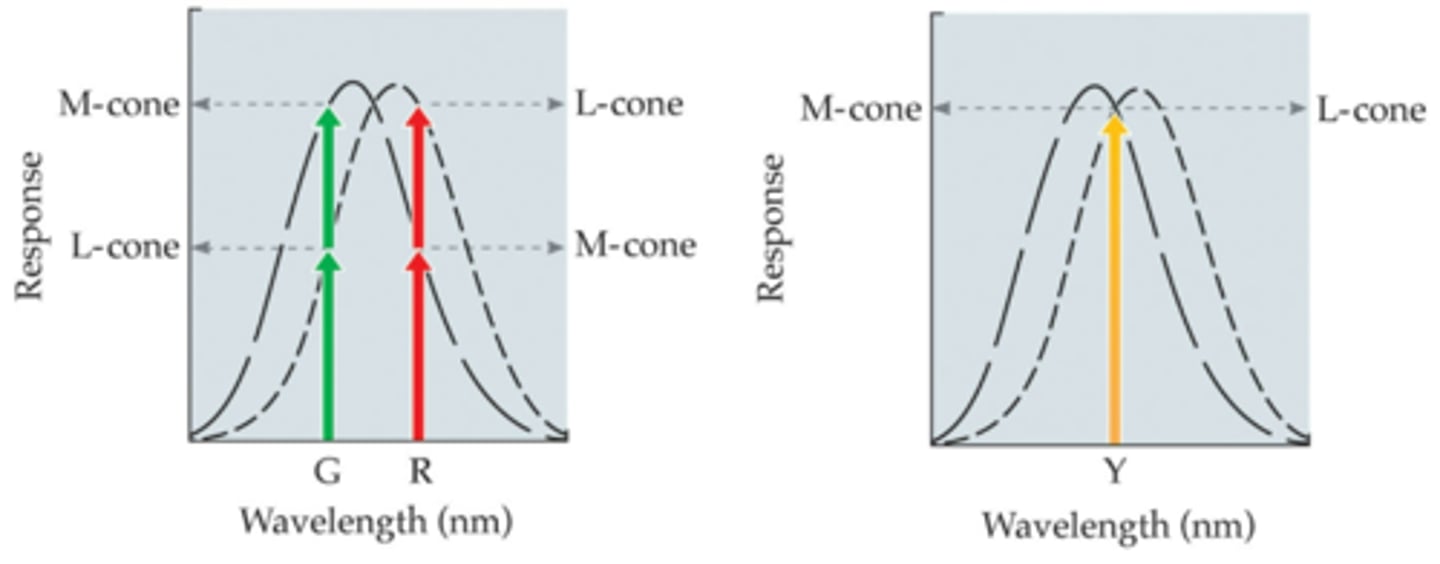Diagrama de PSY280 Midterm (UofT) | Quizlet
1/174
There's no tags or description
Looks like no tags are added yet.
Name | Mastery | Learn | Test | Matching | Spaced |
|---|
No study sessions yet.
175 Terms
Sensation
The result of the physical interaction between the world and our bodies. Inherently limited by our sensory transducers, meaning we never experience reality directly. Different animals can pick up different information than others.
Sensory transducer
A receptor that converts physical energy from the environment into neural energy (such as eyes, ears, etc...).
Perception
The result of the processing and interpretation of neural energy from sensations. Centered around what is important for survival (an unadultered view of reality may be overwhelming). All animals have a unique experience of this.
Nativism
The idea that the mind produces ideas that are not derived from external sources, and that we have abilities that are innate and not learned.
Empiricism
The idea that all knowledge comes through the senses. According to this view, perception is the source of all knowledge about the world.
Modern science largely subscribes to this view.
Panpsychism
The idea that the mind exists as a property of all matter, that is, that all matter has consciousness (i.e. the whole is somehow more than the sum of its parts).
Psychophysics
Invented by Gustav Fechner.
The idea that we can learn about the perceptual process through the empirical measurement of organism's behavioral responses to stimuli; The science of defining quantitative relationships between physical and psychological (subjective) events.
Gustav Fechner
Considered to be the true founder of experimental psychology. Inventor of 'psychophysics'.
Weber's law
The law that states that as a stimulus intensity grows, larger changes are needed to be detectable (i.e. the requirements for a just noticeable difference increase as the physical intensity increases).
Affordances
Coined by James Gibson, this describes the opportunities for action provided by a particular object or environment. Essentially used to describe the relationship between an object and a person.
E.g. A flat surface at the right height can be sat upon.
Absolute threshold
The minimum stimulation needed to detect a particular stimulus 50 percent of the time.
Two-point threshold
Minimum distance necessary between two points of stimulation on the skin such that the points will be felt as two distinct stimuli.
Just noticeable difference (JND)
The smallest detectable difference between two stimuli, or the minimum change in a stimulus that can be correctly judged as difference from a reference stimulus.
Signal detection theory
A psychophysical theory that quantifies the response of an observer to the presentation of a signal in the presence of noise (i.e. how likely are the able to distinguish a stimuli among background noise).
Distinguishing calls are dependent on sensitivity (d') and criterion.
Criterion
Signal detection theory: An internal threshold set by the observer (the vertical dotted line in SDT graphs) for determining if a specific sound is present among noise.
If the perceived stimulus intensity passes the threshold, then we guess 'yes'.
There is usually potential for a false alarm as some instances of 'noise alone' may occur past the threshold.
Sensitivity (d')
Signal detection theory: The ease with which an observer can tell the difference between two stimuli.
In terms of SDT graphs, the larger this is, the further the peaks of 'noise alone' and 'target + noise' are from each other.
This means less overlap, which means less potential for false alarms and misses. Ultimately, greater is better.
Electrocorticography (ECoG)
A type of EEG that is recorded through electrodes placed directly on top of the brain (invasive surgery).
Transverse waves
Waves in which the particles move perpendicular to the direction of motion (like an ocean wave).
Light is composed of two perpendicular waves of this type (electric and magnetic).
Longitudinal waves
Waves in which the particles move parallel to the direction of motion (like an accordian).
Sound waves are this type. In open air, they travel radially outward from the source, whereas in a closed space (like a tube) they travel in one direction.
Natural (fundamental) frequency
The specific frequency object vibrate at most readily (think flicking a wine glass).
Short things have it higher that long things. Matching this frequency increases its amplitude (see Tacoma Narrows bridge disaster).
Absorption
One of the physical manipulations that can happen to light. Happens when it's energy is taken up by an object, without being reflected or transmitted.
The energy in this case turns into heat.
Diffraction
One of the physical manipulations that can happen to light. Happens when light waves encounter an obstacle and bend around it.
This effect is more pronounced on long wavelengths than short wavelengths.
Reflection
One of the physical manipulations that can happen to light. Happens when energy is redirected after striking a surface.
In many cases, some wavelengths will be redirected while others will be absorbed (how we see colors).
Transmission
One of the physical manipulations that can happen to light. Happens when energy passes through a surface (it's being neither reflected nor absorbed). Such as when light passes through glass.
In many cases, only some wavelengths pass through while others are absorbed/reflected.
Refraction
One of the physical manipulations that can happen to light. Happens when light energy is altered (like change of direction) when it passes through another medium (think of light passing through water).
Ciliary muscle
The muscle responsible for changing the shape (focus) of the lens; responsible for accommodation.
Nears objects need fat lens, far objects need skinny lens.
Cornea
The transparent "window" into the eyeball.
One of the major players in the refraction of light as it enters the eye. The boundary between the ambient air and this component is where the strongest refraction occurs.
Aqueous humor
The fluid between the cornea and the pupil. Primary role is to deliver oxygen to many parts of the eye. Nutrient rich.
Pupil
The dark opening at the center of the iris in the eye, where light enters the eye.
Besides serving as a window, its primary role is to help the eye adapt to large changes in light levels through dilation and contraction.
Fovea
Part of the retina where the focus of our vision is directed. Has the highest concentration of cones out of anywhere on the retina, which enables very high visual acuity.
Vitreous humor
The transparent fluid that fills the vitreous chamber in the posterior part of the eye (between the pupil and retina).
Very thick and gel-like. Responsible for the "floaties" we see in our vision sometimes.
Optic disk
The gateway where neural information leaves the eye and travels to the thalamus. There are no rods and cones here, creating a blindspot.
Retina
A light-sensitive membrane on the back of the eye that contains rods and cones. This is where the transduction of the physical stimulus (light) into a neural signal occurs in the eye.
One type of rod, three types of cones (S, M, L, responding to short [blue], medium [green], and long [red] light wavelengths respectively).
Myopia
A type of refractive error in the eye where the light entering the eye is focused in front of the retina and distant objects cannot be seen sharply; nearsightedness.

Hyperopia
A type of refractive error in the eye where light entering the eye is focused behind the retina; farsightedness.

Astigmatism
A visual defect caused by the unequal curving of one or more of the refractive surfaces in the eye. Could be the lens of cornea (but it's usually the cornea).
Result is light unevenly distributed across the retina.
Presbyopia
An eye problem where the individual has an inability to accommodate nearby objects due to the decreased effectiveness of their ciliary muscle; "old sight".
Pigment epithelium
The most posterior part of the retina. Provides nutrients to other parts of the retina. Closest to most demanding cells (such as receptor cells).
Graded potentials
In rods and cones, the idea that the more light there is being senses, the less neurotransmitter (glutamate) is being released at the synaptic terminal.
Chromophore
The "light-catching" part of the visual pigments in the retina.
Visual pigments
Light absorbing molecules created and used by photoreceptor cells. Created in the inner segment of photoreceptors and stored (where they catch light) in the outer segment.
Are consumed when light hits them, meaning lots of resources are required to maintain their production.
Bipolar cells
Neurons in the middle layer of the retina. Two types, diffuse (receive input from multiple rods) and midget (receive input from a single cone).
Essentially middlement whos job is to transfer info from the photoreceptors to the ganglion cells.
Lateral inhibition
The pattern of interaction among neurons in the visual system in which activity in one neuron inhibits adjacent neurons' responses. Helps the retina better localize edges/where the signal is coming from.
Ganglion cells
Cells at the front of the retina that take input from bipolar cells. The last stage before information leaves the eye.
Have distinct receptive fields that respond to light in specific areas of the visual field (Can be ON or OFF-center). Input from many photoreceptors makes up the receptive field.
Ignore overall variation in light level.
P ganglion cells
A type of ganglion cell involved in fine visual acuity, colour, and shape processing. Have good spatial resolution and poor temporal resolution.
Midget type cells.
M ganglion cells
A type of ganglion cell involved in motion processing. Good temporal resolution but poor spatial resolution. Parasol type cells.
Retinitis pigmentosa
A family of hereditary diseases that involve the progressive death of photoreceptors and degeneration of the pigment epithelium.
Usually obscures the area of the visual field surrounding the fovea (like a ring around our focus point).
Macular degeneration
A type of disease that results in the progressive degeneration of the macula (fovea). Impairs central vision.
Snellan chart
A chart used to test visual acuity. At 20 feet away, subjects are asked to read various lines of text with differing sizes. Scores in the form of 20/20 (meaning you can identify the same letters at 20 feet away that a person with normal vision can).
Essentially, the higher the first number is compared to the second, the better the vision. E.g. 20/10 is very good while 80/20 is very bad.
Used mainly in America.
Landolt rings
A chart used to test visual acuity. Consists of "C's" oriented in different ways at different sizes. Subjects asked to identify which side of the ring has the gap.
Used mainly in Europe.
Spatial frequency
The number of cycles of a grating per unit of visual angle (usually specified in degrees).
Very high values may be interpreted as a solid color, as receptive fields may overlap with light and dark sections of the grating.
Images can be broken up into high and low values that may be processed in different regions of the brain.
The better the grating aligns with our receptive fields, the better the response.
Contrast
The difference in illumination between a figure and its background.
Contrast threshold
The minimum contrast to detect a pattern at a specific spatial frequency. Graphs of this (with IV spatial frequency) can be used to get an idea of visual acuity. Smaller values mean higher visual acuity.
Contrast sensitivity
The inverse of contrast threshold. Describes at what contrast we can still make out gratings given a specific spatial frequency. Higher values mean higher visual acuity. If a contrast threshold is 0.01, then this value would be 100.
Quite poor at birth, improves gradually with development. Reduces again as we age, but only for high spatial frequencies.
Photopic
Referring to a specific light intensity: daylight vision.
This is when we experience the best contrast sensitivity.
Mesopic
Referring to a specific light intensity: twilight vision. Worse contrast sensitivity that photopic but better than scotopic.
Scotopic
Referring to a specific light intensity: Nighttime vision. This is when we experience the worst contrast sensitivity.
Phase
Describes the position of a grating relative to a receptive field.
Even if gratings align with receptive fields, the positioning may produce different responses, this changing how we interpret the gratings.
Lateral Geniculate nucleus (LGN)
Part of the thalamus, a structure that visual information hits on the way to the striate cortex. Axons of ganglion cells synapse here. Consists of a parvocellular layer and a magnocellular layer.
Acts as a gate to striate cortex. Gate shuts off when we're sleeping, and shuts off when we move our eyes (to prevent major motion blur).
Contralateral processing where left visual field goes to left side of this structure and vise versa.
Parvocellular layer
A layer of the LGN where P ganglion cells synapse.
Magnocellular layer
A layer of the LGN where M ganglion cells synapse.
Striate cortex (V1)
The primary visual cortex where major transformation of visual information takes place. Handles topographical mapping and cortical magnification.
Takes input outputs from ganglion cells in LGN and builds them in many different ways, enabling more complex processing (like orientation detectors).
Left LGN sends to left hemisphere of this cortex and vice versa.
Topographical mapping
The orderly mapping of the world in the lateral geniculate nucleus and the visual cortex. Neurons respond to different regions of space, and they are physically arranged analogously.
Cortical magnification
The amount of cortical area in V1 devoted to a specific region in the visual field. Fovea has 15 times more respective neurons processing information than the periphery.
Images at fixation have a much higher mental resolution.
Visual crowding
A consequence of cortical magnification. The deleterious effect of clutter on peripheral object detection.
Meaning when an object is alone in our periphery, we can dedicate more neurons to discerning it. When its surrounded by clutter, our neurons are spread thin, making it much harder to discern.
(Think of kid in the street example).
Orientation tuning
The tendency of neurons in the striate cortex to respond optimally to certain orientations of lines.
Receptive fields like these are composed of multiple specific ganglion cells synapsing at one neuron in V1.
Ocular dominance
The property of the receptive fields of striate cortex neurons by which they demonstrate a preference, responding somewhat more rapidly when a stimulus is presented in one eye than when it is presented in the other.
Key takeaway is that cortical cells can respond to input from both eyes while LGN cells only respond to input from one eye.
Simple cells
A type of neuron in the visual cortex, discovered by Hubel and Wiesel, which fires most rapidly when a line is presented at a specific angle in a specific part of the visual field.
Can include edge detectors, and stipe detectors.
Complex cells
A type of neuron in the visual cortex which responds to lines of a specific orientation regardless of their position in the receptive field.
Eccentricity and polar angle
Describes distance from fixation and subset of visual field (radial slice) respectively. Combined they form a coordinate system in the striate cortex that corresponds to regions of the visual field.
Hypercolumns
Consists of a complete set of orientation columns (spanning a full 180 degrees), repeated within both right and left ocular dominance columns; can be thought of as a location-specific "processing module" in V1.
Contain blobs which respond to color.
They are intermittently spread out throughout V1, but span the whole visual field.
Columns
Cells in the striate cortex that are organized such that they make up columns of neurons (where each neuron in a column has the same preferred orientation).
Alternating left and right eye input.
Span the whole of V1, unlike hypercolumns.
Selective adaptation
The effect that occurs when V1 neurons that fire in response to a specific orientation begin to tire out. When this happens, cells that respond to other similar orientations begin to take over.
Think of oblique gratings illusion, where the straight lines appear to lean in the opposite direction of the lines we were just staring at. This is the tilt aftereffect which happens as a result of this effect.
Also showed us that we contain neurons that select for spatial frequency which can also get fatigued.
Strabismus
A condition involving the misalignment of eyes such that single object in space is imaged on the fovea of one eye and the non-foveal area of the other (turned) eye; crossed eyes. Can lead to amblyopia if untreated during the critical period.
Treated by patching the dominant eye.
Anisometropia
A condition where the two eyes have different refractive errors (e.g. hyperopia in one eye but not the other). Can lead to amblyopia if untreated during the critical period.
Amblyopia
A developmental disorder characterized by reduced spatial vision in an otherwise healthy eye, even with proper correction for refractive error. Also known as lazy eye.
This occurs when strabismus or anisometropia go untreated during the critical period, resulting in V1 cortical neurons developing improperly.
Middle vision
A loosely defined stage of visual processing that comes after basic features have been extracted from the image and before object recognition and scene understanding.
Involves the perception of edges and surfaces.
Where we start to build features of objects rather than features of visual stimulation (from "this is a line" to "this is an edge of a desk"). Determining which edges/lines go together in an object-based sense.
Illusory contour
Contour that is perceived even though it is not present in the physical stimulus. Result of the gestalt principle of closure.
common fate
The idea that elements that move in the same direction tend to group together in our perception.
Synchrony
The idea that elements that change at the same time (such as changing color) tend to be grouped together in our perception.
Accidental viewpoint
A viewing position that produces some perspective of an object that is not present in the real world, such as seeing all the vertices of a cube at once.
Gestalt perception assumes we won't encounter views like these.
Camouflage
A technique used by some animals in nature where they attempt to break gestalt grouping rules so that its features are not perceived as an object on its own, but as parts of a larger object or background.
Can also be used by humans to confuse, rather than hide (see "dazzle camouflage").
Figure-ground assignment
The process of determining that some regions of an image belong to a foreground object (figure) and other regions are part of the background (ground).
Determining principles include surroundedness, size, symmetry, and parallelism. In general, we have a strange amount of control over our assignments.
Nonaccidental feature
A feature of an object that is not dependent on the viewing position of the observer, such as the angle of vertices on an object.
Examples of how these influence perception:
T-junctions indicate occlusion, Y-junctions indicate corners facing the observer, arrow-junctions indicate corners facing away from the observer.
Global superiority effect
The properties of the whole object take precedence over the properties of parts of the objects (e.g. Navon letters... think HCL vs SNU).
Pandemonium model
A model of letter perception based on a bottom-up hierarchy of image demons -> feature demons -> cognitive demons -> decision demons.
Entry-level category
For an object, the label that comes to mind most quickly when we identify it (e.g., "bird"). At the subordinate level, the object might be more specifically named (e.g., "eagle"); at the superordinate level, it might be more generally named (e.g., "animal"). Generally, the less typical the member, the more specific categorization level we use.
Each individual has their own entry-level category, whos specificity changes based on knowledge of the category.
Extrastriate cortex
The region of cortex bordering the primary visual cortex where more high-level processing happens.
E.g. Can determine boundary ownership when processing edges (i.e. can determine which sides of the edge correspond to figure and ground).
General rule is that the farther away from V1 we move (down the ventral stream), the more complex processing becomes.
Inferotemporal (IT) cortex
Lower portion of the temporal lobe, part of the "what" pathway. The receptive fields of the neurons here respond to whole, categorized objects.
e.g. We have cells that respond to tools, vehicles, animals, body parts, faces, etc..
Inanimate agnosia
The inability to recognize inanimate objects.
Problem of univariance
The fact that an infinite set of different wavelength-intensity combinations can elicit exactly the same response from a single type of photoreceptor.
This means color discrimination must rely on input from multiple cones.
Trichromacy
The theory that the color of any light is defined in our visual system by the relationships of three numbers, the outputs of three receptor types now known to be the three cones: Short (blue) cones, medium (green) cones, and long (red) cones, or RGB.

Additive color mixture
A mixture of lights. If light A and light B are both reflected from a surface to the eye, in the perception of color the effects of those two lights add together. Important to know that mixing wavelengths does not change their physical properties, the apparent mixture is a result of our perception.
Typically occurs when light emitters are so close together that our retinas cant distinguish them (think LCD monitors).
Metamers
Different mixtures of wavelengths that look identical. More generally, any pair of stimuli that are perceived as identical in spite of physical differences.
In the image, we see the same total M and L responses, even though they're different wavelengths.

Subtractive color mixture
A mixture of pigments. If pigments A and B mix, some of the light shining on the surface will be subtracted by A, and some by B. Only the remainder contributes to the perception of color. Both absorption properties combine to absorb more colors. What's not absorbed (left over) is what we see. Creating colors by taking wavelengths away.
This is what's happening when we mix paints together.
Pigments
Substances that absorb light at some wavelengths, and reflect light at others. A 'blue' pigment would absorb red and green wavelengths and reflect blue wavelengths.
Dithering
A form of color color quantization, resulting in a reduction of the number of colors needed. Utilizes additive color mixing by using a small amount of colors at different intensities and placing them close together so their wavelengths add together.
Used by printers.
Color space
The three-dimensional space, established because color perception is based on the outputs of three cone types, that describes the set of all colors.
S, M, and L responses serve as the coordinates to navigate this space.
Can also be defined in terms of hue, saturation and brightness, or HSB spaces.
RGB spaces are cubes, HSB spaces are cones.

Hue
One of the coordinates in an HSB color space: The chromatic (color) aspect of light. Defines what the 'base' color is.
Saturation
One of the coordinates in an HSB color space: The chromatic strength of a hue (how much hue in light).